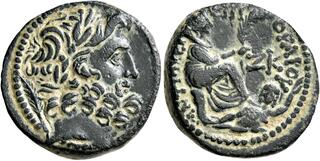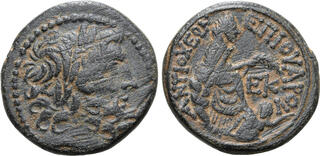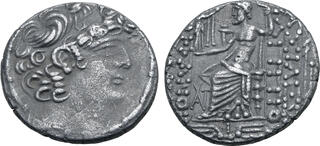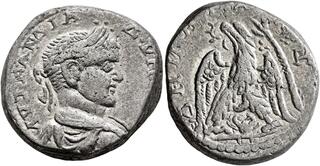Match 1:
Match 2:
Match 3:
| Heritage World Coin Auctions > Showcase Auction 61379 | Auction date: 27 May 2024 |
| Lot number: 24068 Price realized: This lot is for sale in an upcoming auction - Bid on this lot  | |
| Lot description: Ancients SYRIA. Antioch. Augustus (27 BC-AD 14). AR tetradrachm (25mm, 15.01 gm, 12h). NGC Choice VF 4/5 - 3/5. Dated Actian Era Year 36 and year 54 of the Caesarean Era (AD 6). ΚΑΙΣΑΡΟΣ ΣΕΒΑΣΤΟΥ, laureate head Augustus right; bead-and-reel border / ANTIOXEΩN-MHTPOΠΟΛΕΩΣ, Tyche seated right on rock, palm in outstretched right hand; river god Orontes swimming right before; ϚΛ (date) above, ΠΑY monogram and ΔΝ (Cos) over ΑΝΤX monogram in left field; dotted border. Prieur 57. RPC I 4158. https://coins.ha.com/itm/ancients/roman-provincial/ancients-syria-antioch-augustus-27-bc-ad-14-ar-tetradrachm-25mm-1501-gm-12h-ngc-choice-vf-4-5-3-5/a/61379-24068.s?type=DA-DMC-CoinArchives-WorldCoins-61379-05272024 HID02906262019 © 2024 Heritage Auctions | All Rights Reserved |  |
Match 4:
Match 5:
| Leu Numismatik AG > Auction 15 | Auction date: 1 June 2024 |
| Lot number: 191 Price realized: This lot is for sale in an upcoming auction - Bid on this lot  | |
| Lot description: SYRIA, Seleucis and Pieria. Antioch. Pseudo-autonomous issue, time of Augustus, 27 BC-AD 14. Trichalkon (Bronze, 19 mm, 7.10 g, 11 h), P. Quinctilius Varus, legate of Syria, CY 27 (Actian Era) = 5/4 BC. Laureate head of Zeus to right; behind, palm frond. Rev. [ΑΝΤΙ]ΟΧΕΩΝ ΕΠΙ ΟΥΑΡΟΥ / ZK The Tyche of Antioch seated to right on rock, holding palm branch in her right hand; below, river-god Orontes swimming right. CNG E-Auction 545 (2023), 429 corr. (same dies, but palm frond not noted). McAlee 87A (same obverse die). RPC I 4252 var. (no palm frond). Extremely rare and of great historical interest. A beautiful example of this interesting issue with very attractive earthen highlights. The reverse struck slightly off center, otherwise, good very fine. Ex Naumann E-Auction 114, 6 March 2022, 599. The extremely unusual palm frond behind the head of Zeus appears only on a single die of Varus from the year 27 after the Actian Era, corresponding to our year 5/4 BC. As a military victory symbol, F. Kovacs associates it with the expedition of the Syrian governor to Jerusalem in 4 BC. The background was Varus' involvement in the inheritance dispute of Herod, who in 5 BC accused his son and heir Antipater of attempted patricide. In his capacity as the governor of Syria, Varus was tasked with overseeing the adjudication of this matter. He sentenced the accused to death, a judgment ratified by Augustus and carried out in March 4 BC, mere days before the passing of Herod the Great. Prior to this, the monarch had designated his son Archelaus, born of his union with Malthake, as his successor. The ensuing inheritance dispute with Herod Antipas and Herod II prompted Varus to send the three brothers to Rome for judgment. In spring 4 BC, the Roman procurator Sabinus traveled to Jerusalem. Defying the governor's directives, he attempted to appropriate Herod's estate and loot the temple treasury, sparking a Jewish rebellion. Sabinus and his retinue soon found themselves besieged by insurgents within a fortress in Jerusalem, only being freed when Varus himself appeared on the scene with a relief force of two Syrian legions. Faced with the spreading revolt, the governor cracked down hard and, according to Josephus, had the uprising crushed and 2,000 Jews crucified. This resounding military success may explain why a palm branch appears as a symbol of victory on our coin, which was likely minted in the summer of 4 BC. Rome remained victorious, but the suppression of the uprising and the mass execution of insurgents undoubtedly fueled hatred against the occupying power and laid another cornerstone for the later Jewish rebellions against the Empire. From a Roman standpoint, however, the quelling of the rebellion marked a resounding success, propelling Varus further along the trajectory of his career. In 7 AD, he became the first governor of the newly established province of Germania. Two years later, instead he gained eternal infamy when he fell victim to the ambush orchestrated by Arminius, which culminated in the devastating Battle of the Teutoburg Forest where Varus' entire army was annihilated. Varus, in despair, met his tragic end by his own hand, marking the abrupt end of his illustrious career and prompting the withdrawal of Roman troops from the new Germanic province. Estimate: 2500 CHF |  |








